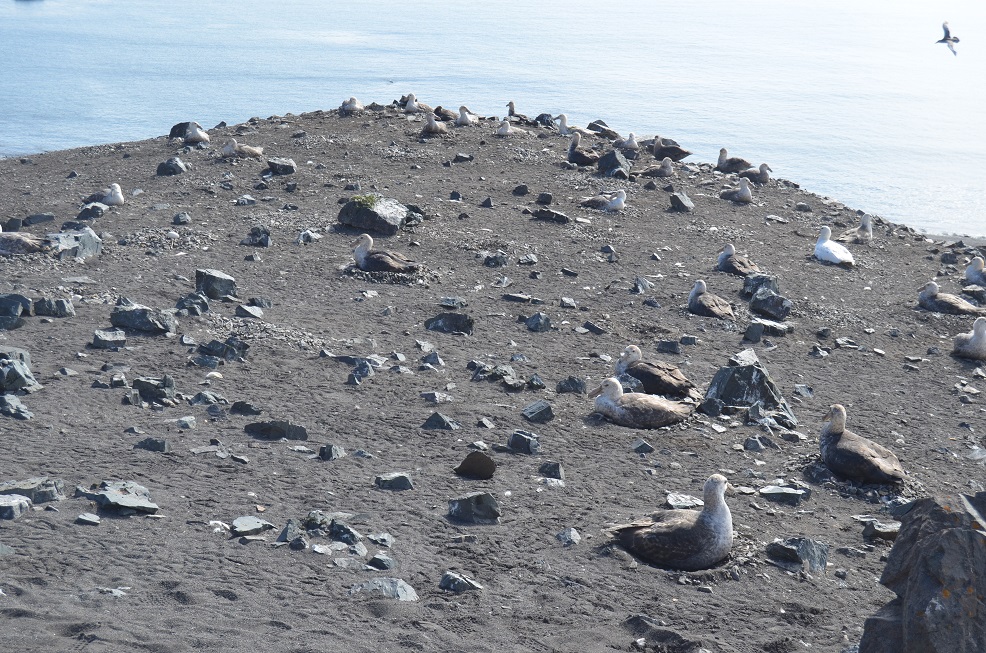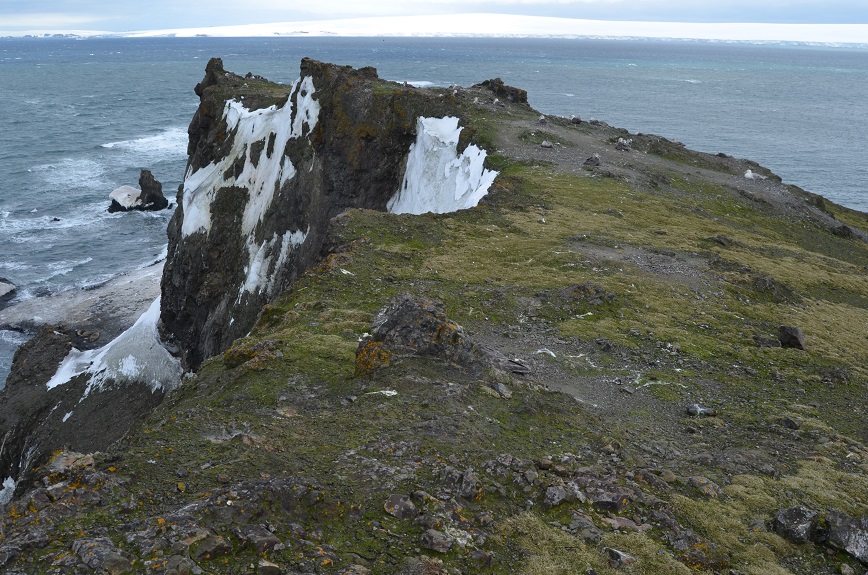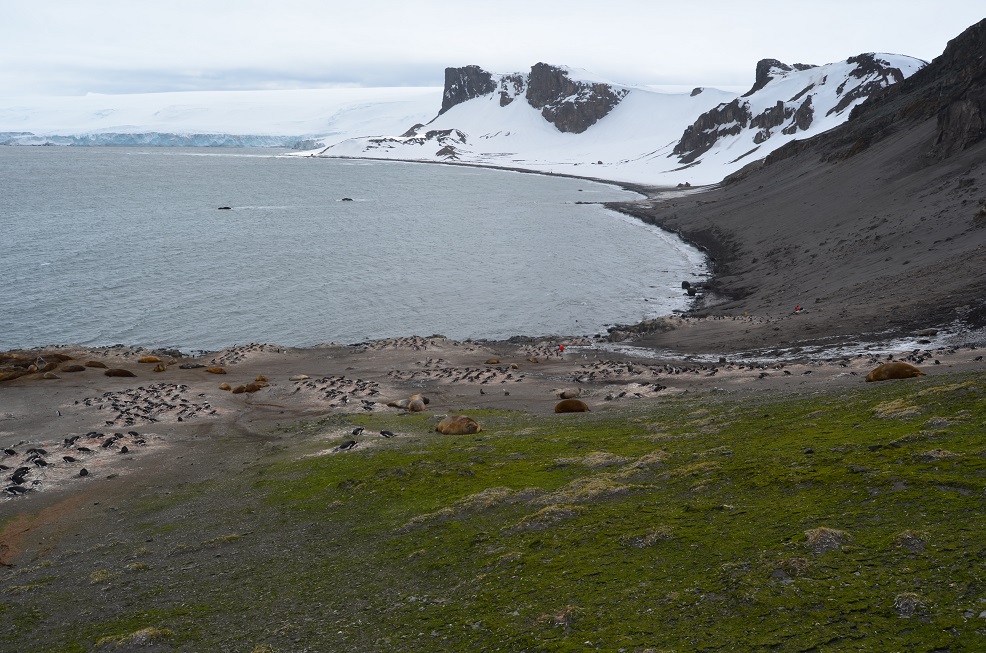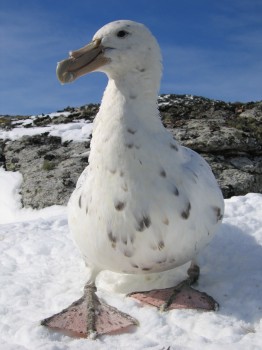Livingston Island belongs to the South Shetland Island group in Maritime Antarctica. It lies between Snow Island and Greenwich Island, approximately 110 km from the Antarctic Continent, separated by the Bransfield Strait. The Southern Giant Petrel Macronectes giganteus is the only ACAP-listed species breeding on Livingston Island, at two known localities, Hannah Point and Byers Peninsula (ACAP Site No. 85).
Hannah Point is a narrow peninsula on the south coast of Livingston Island of c. 122 ha with elevations 30 to 50 m above sea level. The area becomes ice-free during the austral summer mainly due to steep slopes and hills that do not accumulate ice and snow.
The Southern Giant Petrel population at Hannah Point is of c. 308 breeding pairs divided into six breeding groups and some solitary nests, according to the last ground census in December 2012 by Brazilian researchers from the Universidade do Vale do Rio dos Sinos. This represents a marked increase from counts of only 17 pairs in 1958, 24 pairs in 1986, and 110-246 occupied nests from 1997/98 to 2005 by the Antarctic Site Inventory. Nests are located on elevated areas with gentle slopes covered by sediment, boulders and pebbles, which are used in nest construction.

A Southern Giant Petrel colony at Hannah Point

A White-phase Southern Giant Petrel on its pebble nest at Hannah Point
Due to the high frequency of tourists visiting Hannah Point each year the area is managed by a Visitor Site Guide document produced by the Antarctic Treaty System.
Views of Hannah Point

Moss and pebbles make a Southern Giant Petrel nest at Hannah Point
Photographs by Maria Virginia Petry.
Selected Literature:
Antarctic Treaty System 2014. Hannah Point Antarctic Treaty Visitor Site Guide. 2 pp.
Harris, C.M., Lorenz, K., Fishpool, L.D.C., Lascelles, B., Cooper, J., Coria, N.R., Croxall, J.P., Emmerson, L.M., Fijn, R., Fraser, W.L., Jouventin, P., LaRue, M.A., Le Maho, Y., Lynch, H.J., Naveen, R., Patterson-Fraser, D.L., Peter, H.-U., Poncet, S., Phillips, R.A., Southwell, C.J., van Franeker, J.A., Weimerskirch, H., Wienecke, B. & Woehler, E.J. 2015. Important Bird Areas in Antarctica 2015. Cambridge: BirdLife International and Environmental Research & Assessment Ltd. 302 pp.
Lynch, J.J., Naveen, R. & Fagan, W.F. 2008. Censuses of penguin, Blue-eyed Shag Phalacrocorax atriceps and Southern Giant Petrel Macronectes giganteus populations on the Antarctic Peninsula, 2001-2007. Marine Ornithology 36: 83-97.
Naveen, R. 1997. The Oceanites Site Guide to the Antarctic Peninsula. Chevy Chase: Oceanites Inc. 129 pp.
Naveen, R. 2003. Compendium of Antarctic Peninsula Visitor Sites 2nd Edition. A Report to the United States Environmental Protection Agency. Chevy Chase: Oceanites Inc. 381 pp.
Naveen, R., Forrest, S.C., Dagit, R.G., Blight, L.K., Trivelpiece, W.Z. & Trivelpiece, S.G. 2000. Censuses of penguin, Blue-eyed Shag, and Southern Giant Petrel populations in the Antarctic Peninsula region , 1994-2000. Polar Record 36: 323-334.
Patterson, D.L., Woehler, E.J., Croxall, J.P., Cooper, J., Poncet, S., Peter, H.-U., Hunter, S. & Fraser, W.R. 2008. Breeding distribution and population status of the Northern Giant Petrel Macronectes halli and the Southern Giant Petrel M. giganteus. Marine Ornithology 36: 115-124 & appendices.
Poncet, S. & Poncet, J. 2007. Southern Ocean Cruising Second Edition. Cambridge: Environmental Research & Assessment. 160 pp.
Maria Virginia Petry & Júlia Victória Grohmann Finger, Laboratório de Ornitologia e Animais Marinhos, Universidade do Vale do Rio dos Sinos, São Leopoldo, Brazil, 31 May 2017

 English
English  Français
Français  Español
Español 







